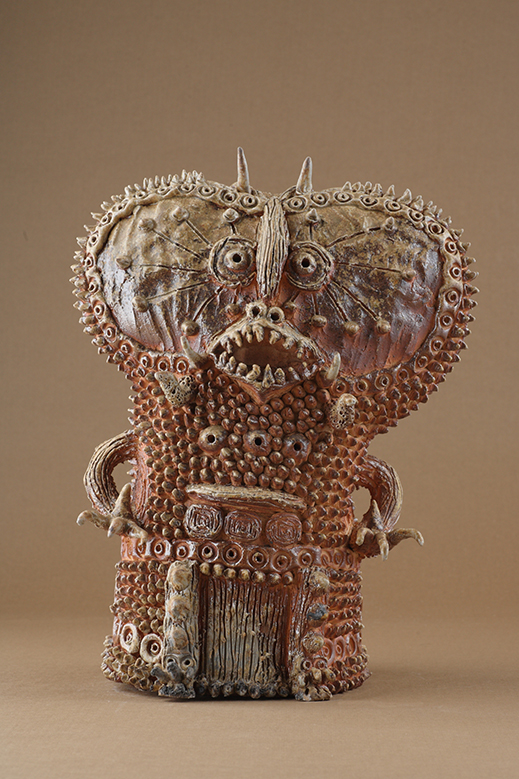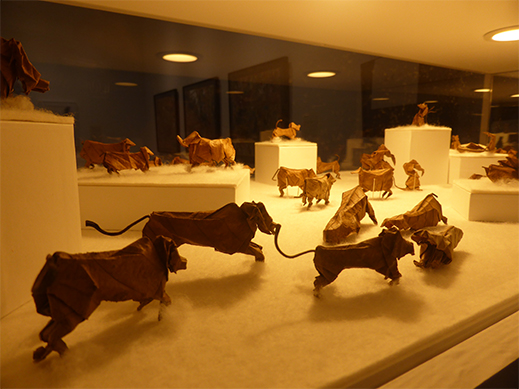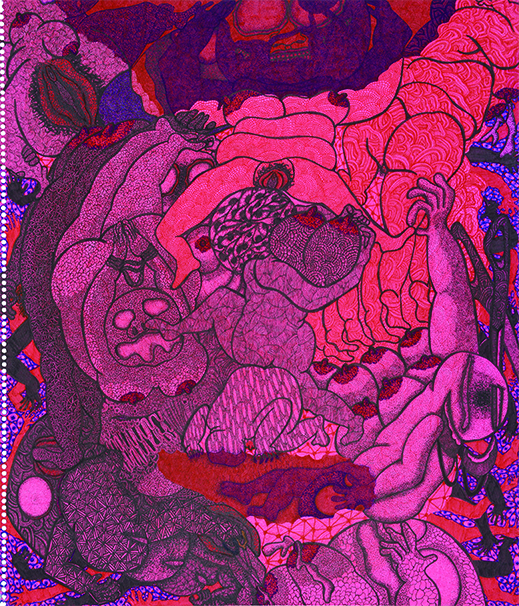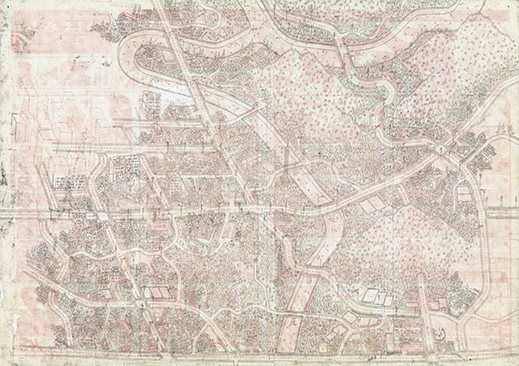 |
Focus features two in-depth reviews each month of fine art, architecture, and design exhibitions at art museums, galleries, and alternative spaces around Japan. |
|
|
 |
 |
 |
Art Brut 2020: Creative Currents in Full Flow
J.M. Hammond |
 |
Sekio Minobe, Untitled, date unknown. Photo by Satoshi Takaishi |
In today's highly commercialized and commodified world, art is all too often considered a specialized activity limited to highly trained professionals. But this view of art overlooks the fact that imagination and the urge to create is something that lives in many, maybe even all, of us . . . and that some of the most striking images are the product of untrained artists.
The term Art Brut was coined in the 1940s by the French artist and critic Jean Dubuffet to describe the output of individuals, often those with mental health problems, with no formal art education or art-world recognition. The equivalent term in English, Outsider Art, was introduced later, by the art historian Roger Cardinal (under whom the writer of this article had the pleasure to study).
Attention to this type of unbridled creativity has been growing among art enthusiasts in Europe and America ever since, but it is only in the last decade or so that Japan has taken an active interest in the field, with dedicated exhibitions of some of the celebrated practitioners that put Art Brut on the map, such as Henry Darger, Aloïse Corbaz, and Adolf Wolflli.
|
 |
|
|
|
Shinichi Sawada, Untitled, 2010-2011. Photo by Masumi Takada
|
Now, a new exhibition in Tokyo is focusing on works created by a number of Japanese artists, with a few from overseas also included. Art Brut 2020 Special Exhibition (subtitled "In a sky full of shining stars, unknown gems can be found. -To feel change and expansion in our universe.-") runs until 6 December at Tokyo Shibuya Koen-dori Gallery, which opened in February this year. This is not the first-ever sizable exhibition of Japanese Art Brut, but is notable for being held at a gallery that concentrates on the promotion of this particular area of art. The exhibition features around 90 works by 18 different artists.
The overriding perception of Art Brut, or Outsider Art, is of crude, wild, sometimes childlike images. There are certainly some examples of this here, in particular the sculptures of Shinichi Sawada, which have echoes of tribal or ancient Japanese Jomon-era works. But as we will see, this is just one aspect of Art Brut.
Another general observation that could be made about Outsider artists, and is applicable to some of those featured in this exhibition, is that they rarely use the traditional materials of fine art, often turning to everyday materials, perhaps whatever is at hand or what suits their purposes.
 |
|
Yoshihiro Watanabe, Animals Made from Folding Leaves, 2003-2017. Photo by J.M. Hammond
|
One of the most striking examples of this tendency is the work of Yoshihiro Watanabe, who crafts miniature animal figures out of the leaves of the sawtooth oak tree that fall in autumn. Among the dozens on display in a glass case at the start of the exhibition one can spot elephants, dogs and snakes. Watanabefs dexterity is not limited to these figures, however; he is also active in paper-cutting and making ceramics.
On sheets of paper, Satoshi Morita uses pencil to draw the outlines of his human and animal figures, and ballpoint pen to fill them in with dots and lines. In addition to some monochrome works, included here is a fantastic creature brought to life in full color. Marie Suzuki also uses pens, hammering out three or four dots per second onto the paper, and, like Morita, creating dense, energetic pictures. Enveloped in patterns vaguely reminiscent of vegetation, her subject matter often revolves around rhythmical depictions of scissors, breasts, and genitalia, as in her work A Blob of Complex.
 |
|
Marie Suzuki, A Blob of Complex, 2015. Photo by Nobuo Onishi
|
This kind of compulsive repetition of a limited set of motifs or elements is another hallmark of many practitioners of Art Brut, including many of the artists included here. For example, 25-year-old Shogo Harazuka has been producing imaginary bird's-eye views of major cities since he was about ten years old, and all of Shota Katsube's creativity has been geared toward making miniature action figures, or science-fiction warriors, out of the colorful plastic ties used to secure bags of food, such as bread.
This singular focus is also evident in the repetitive depiction of trains that characterizes the work of Hidenori Motooka. Curiously, he never draws the trains in full length or in motion, but always head-on or from above in tightly packed rows. Motooka's works highlight an aspect of Art Brut that contradicts the stereotypical image of wild, chaotic expression -- namely, a striving toward clear, even rigid, visual order.
Much has been said of the horror vacui -- a fear of emptiness and the tendency to fill every inch of space -- in Art Brut, and something of this can be spotted among the artworks here, such as Shogo Harazuka's city maps or Suzuki's dense inner landscapes.
 |
|
Shogo Harazuka, Cities that Connect, 2006-2017 (detail). Photo by Satoshi Takaishi
|
On the other hand, the work of Yasuhiro K. suggests quite the opposite. His portrayals of Sapporo City, one made every summer over a number of years, have modulated over time from a detailed view spanning the width of the paper to a localized concentration on a few details in one corner of the sheet, leaving the majority of the space blank.
So it should be clear that any comments that can be made about Art Brut are only general observations, and far from hard and fast rules -- though they can offer some pointers in approaching this area of activity.
As mentioned earlier, another name for Art Brut is Outsider Art, which raises the question: "outside" of what exactly? One view, and perhaps the most reasonable, is that it refers to creators working outside of the established art world -- no formal art training, no gallery or agent or the like, no desire for fame or monetary reward. A broader interpretation posits these artists as working outside of mainstream society and culture altogether, as though they live in enclosed mental worlds that are entirely their own. This description, however, often does not hold water, as many of the artists -- including a number in this exhibition -- actively borrow from or interact with images in circulation in wider society.
 |
|
Yuichiro Ukai, Ship, 2019. Photo by Social Welfare Corporation Yamanami, Atelier Yamanami |
Yuichiro Ukai's pictures, for example, borrow from manga, anime, and images he discovers in illustrated and picture books. These include reproductions from ukiyo-e woodblock prints, and, seemingly, nanban pictures -- art created in Japan in the 16th and 17th centuries portraying the foreigners who arrived on the country's shores during that period. His highly detailed works often feature foreigners wearing garments of the time and the boats they arrived in -- these being just a few of the motifs he mixes in among more fantastic imagery such as dinosaurs, skeletons, and ghosts, as in Ship above.
Whatever Art Brut is exactly, there is little doubt that it can be powerfully expressive, exhilarating, and inspiring, as Art Brut 2020 amply demonstrates.
All images courtesy of or by permission of Tokyo Shibuya Koen-dori Gallery.
|
 |
 |
J.M. Hammond
J.M. Hammond researches modernity in Japanese art, photography and cinema, and teaches in Tokyo, including as a faculty lecturer in the English department at Meiji Gakuin University and at Gakushuin University. He has written about art for The Japan Times for over a decade. His essays include "A Sensitivity to Things: Mono No Aware in Late Spring and Equinox Flower" in Ozu International: Essays on the Global Influences of a Japanese Auteur (Bloomsbury, 2015) and "The Collapse of Memory: Tracing Reflexivity in the Work of Daido Moriyama" for The Reflexive Photographer (Museums Etc, 2013) [reprinted in the same publisher's 10 Must Reads: Contemporary Photography (2016)]. He has given various conference papers, including at the University of Hong Kong and the University of Oxford. |
|
 |
|